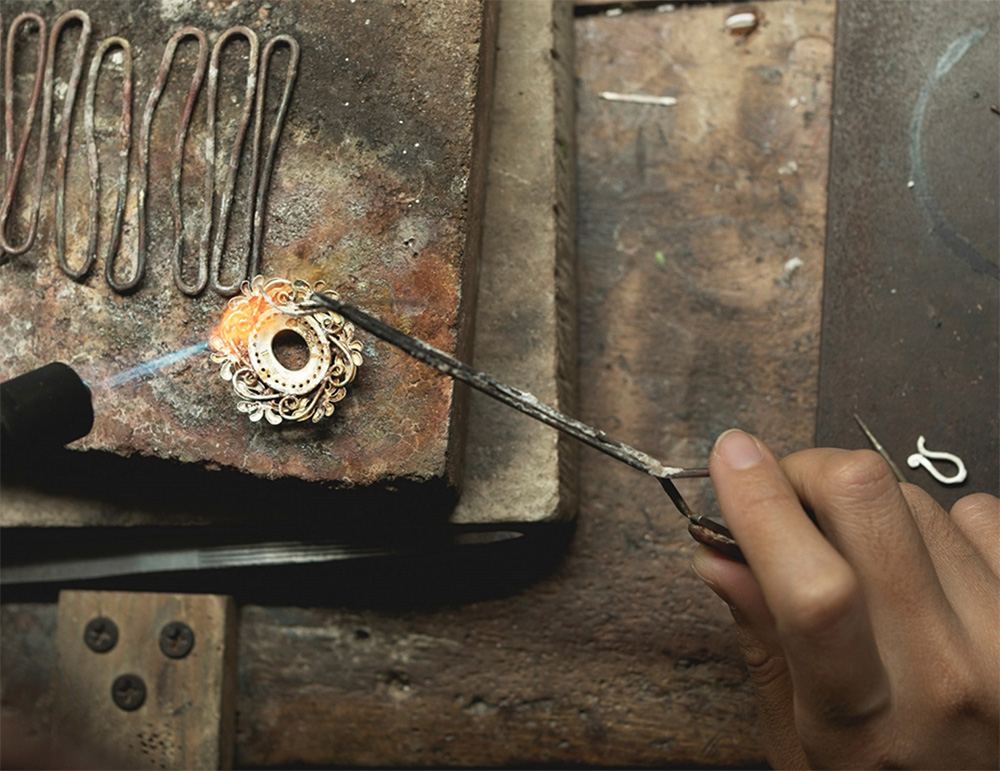Although custom jewelry seems like a recent trend, it has been popular for centuries, if not for millennia. Ancient people decorated their bodies with all kinds of natural materials ranging from shells to animal bones. As they became more civilized, metals and stones began to be used, necessitating more complicated techniques, such as soldering, producing alloys, cutting stones, filigree work, engravings, cameos, intaglios, repoussé, enameling, glazing, granulation, gilding, inlaying, and many others.
Most ancient civilizations have left their mark by producing their own “brand” of jewelry, deeply steeped in cultural beliefs and mythology. While the oldest archeological jewelry finds are mostly connected with burial sites, we believe that jewelry was never meant to celebrate death but rather life. It is a constant reminder of how beautiful a human body is and how a simple physical object can go well beyond its decorative purposes. An ornamental piece can embody a concept, a belief, or even a cultural code. This is why some of the most progressive custom jewelry companies on the market, such as Olertis, will go above and beyond to achieve not only technical perfection but also personalized meaningfulness when creating jewelry.
From Ancient Egypt to Greece and Rome, and from Ancient China to India – people have been known to produce remarkable works of art that fascinate us with their brilliance even today. Take, for example, the pieces discovered at Queen Pu-abi’s tomb that date back five thousand years ago. The Sumerian beauty was covered in jewelry almost from head to toe. The deep meaning behind jewelry motifs and their mythological roots are no less intriguing. Let’s consider some of the most popular motifs and inspiration sources used by ancient cultures for their jewelry:
- Sumerians: geometric shapes, solar and floral motifs;
- Egyptians: scarab beetle, snake, sphinx, tiet, ankh (the symbol of life), eagle, sun, etc.;
- Phoenicians: animals (especially birds of prey), human faces, flowers, geometric designs;
- Etruscans: mythological creatures with wings, sphinx, cattlemen, boats, half-circles, tubes;
- Aegeans: burial-themed motifs, circular disks, rectangles, and other geometric shapes, floral and animalistic motifs;
- Greeks: mythological creatures and even scenes from myths, animals (snakes, horses, birds), Hercules knots, floral and geometric shapes;
- Romans: flowers and leaves (especially fern-shaped), half-circles, crosses, phallic shapes, lions, snakes, and other animal-inspired themes;
- Indians: religious themes, geometric designs, bird feathers, plant-inspired motifs, etc.;
- Chinese people: dragons, birds, and other animals, floral themes, depictions of people.
It’s true that the honor of wearing custom jewelry was mostly reserved for royalty during the larger part of human history. It wasn’t until the 19th century that technology allowed jewelry to be mass-produced. And with that, came its own kind of challenge. Although now most middle-class people could enjoy the luxury of an exquisite enamel brooch or a golden pendant, the people unknowingly have become slaves to industrial standardization. Mass-produced jewelry completely lost the personal feel of vintage items, which gradually caused dissatisfaction among the customers. However, the middle and lower class still needed a solution to that for a long time as they couldn’t afford the luxury of custom-made jewelry up until several decades ago. And it’s only with the advent of 3D printing technology that intricate custom pieces became truly affordable for most people. This is why Olertis believes that modern technology holds the keys to the jewelry industry of the future where any customer can get a perfectly personalized piece that is meant just for them. A mystical locket, a commemorative brooch, a holiday-themed bracelet, an elegant ring bracelet, an original puzzle pendant, or any other piece that blurs the lines between different types of jewelry – you may surprise even yourself with what you can create!

With this being said, there is always a place for handmade low-key jewelry that catches your eye but doesn’t hold a high value. Many artisans still prefer to do everything by hand which gives their products a special personal touch. However, we believe in a different approach: one where personalization and a great sense of involvement in the creation process are coupled with the efficiency of modern technology. This is essentially what our modern era is about: fusing inherently human and personal approach to things with high-tech solutions that make processes more streamlined, precise, and optimized.





